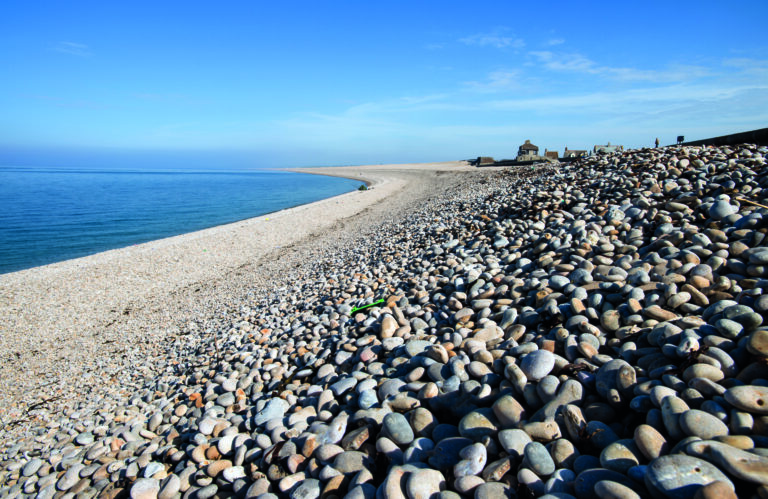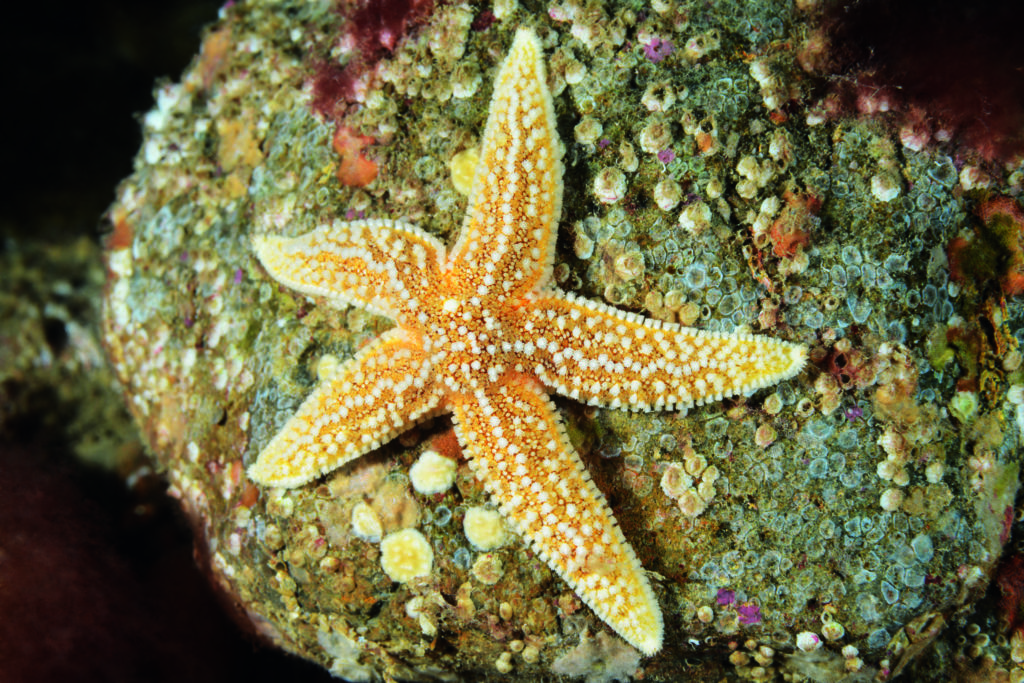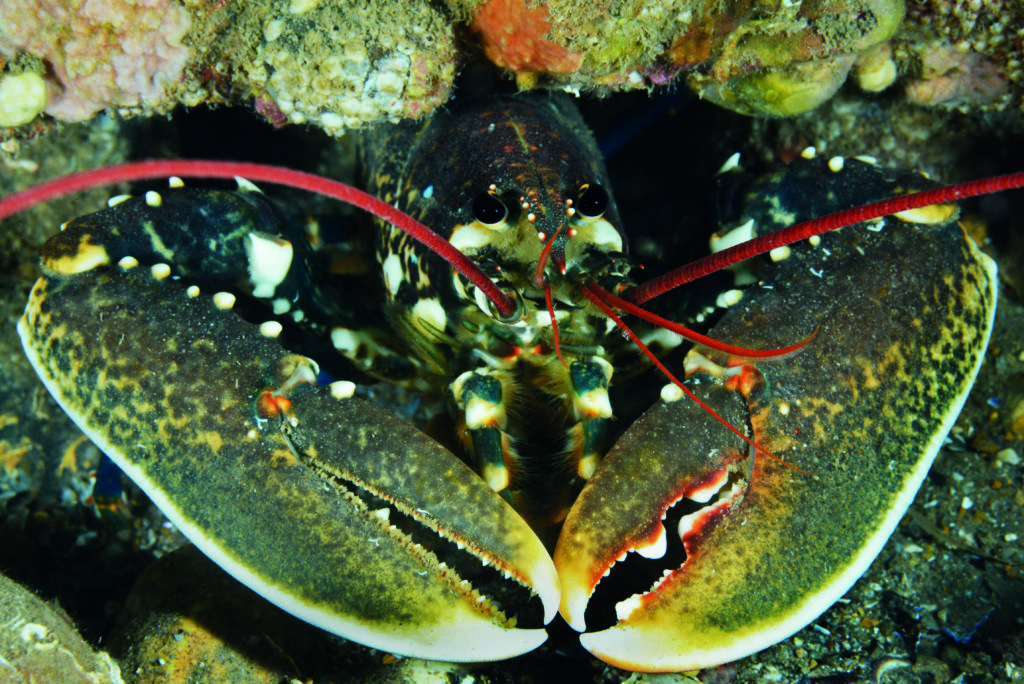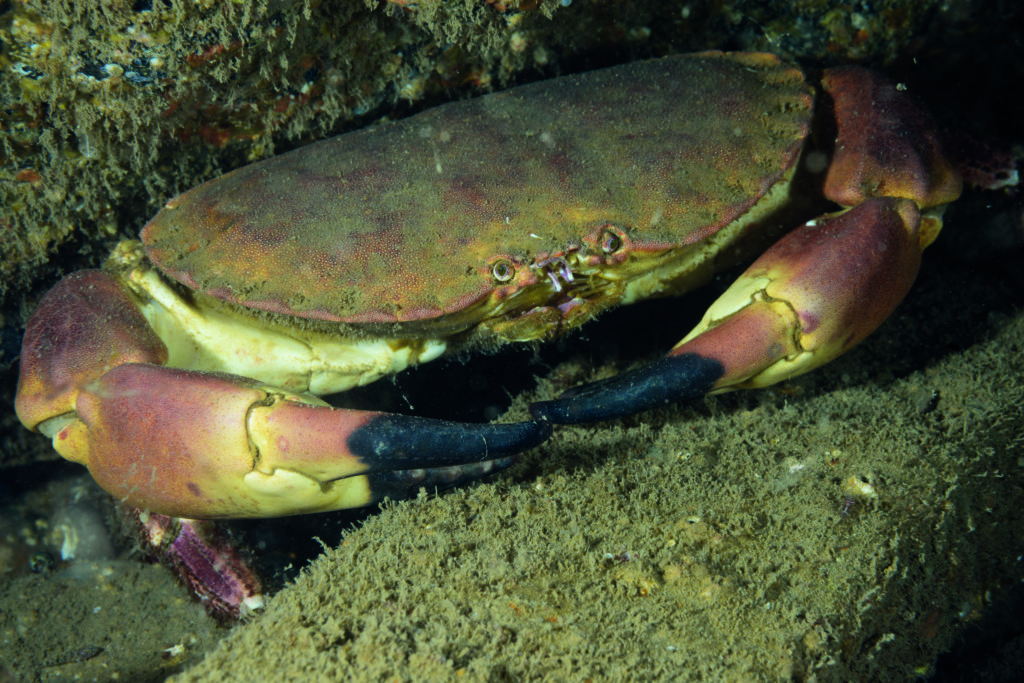STUART PHILPOTT has dived this Dorset site many times, and remains content to take on the ‘Chesil Challenge’ – would you be?
Chesil Bank in Dorset is a spectacular example of a shingle beach. Made from hundreds of billions of pebbles, it’s roughly 28km long, 160m wide and up to 15m high. Hand-sized pebbles are found to the south at Chiswell Cove on Portland, gradually reducing in size to small marble-sized stones at West Bay to the north-west.
Overview of Chesil
This all adds up to one of the best shore-diving sites on England’s South Coast. But, as with many things in life, there is no gain without pain. Walking up and over Mount Chesil in full diving kit, especially on a hot summer’s day, can be a severe shock to the system and usually goes hand in hand with a barrage of four-letter expletives. Be assured, once experienced never forgotten.
So is this shore-dive just for diehard masochists? For the past 25 years I have been making the climb, on some occasions twice and, if I’ a’m feeling particularly stupid, three times in a day. But when weather conditions are calm and underwater visibility tops 10m, it’s well worth crossing this pain barrier.
Marine-life sightings can be exceptional, with a huge variety of species on show from undulate rays, john dory, cuttlefish and crawfish to bog-standard lobsters, edible crabs, shoals of pouting, bass, pollack and wrasse.
Over the years, Chesil has seen its fair share of shipwrecks. Parts of World War Two landing-craft, the Royal Adelaide and the Nor provide refuge for many species, as well as seasonal visitors, including the awesome grey triggerfish. There are also a number of “secret“ historical wreck-sites scattered with cannon and other relics, but these are out of bounds to recreational divers.
Arrival at the site
I have never dived at the West Bay end. Some local dive-guides mention the WW2 wreck of a B17 Flying Fortress that crash-landed near Abbotsbury, but after decades of storms I doubt there is much left to see. For the purpose of this review, I have focused on the places with which I’m familiar, the Portland shore-dive sites.
Follow the Portland beach road (A354) onto the causeway. The Fleet lagoon is on the right and a boatyard is on the left. After crossing the bridge, use the car-park on the right next to the Fine Foundation Chesil Beach Centre for the Royal Adelaide and landing-craft wrecks.
Facilities include an onsite café and reasonably clean public toilets. Parking costs £2 for two hours. Stay close to the beach-centre for the Royal Adelaide and cross the wooden bridge by foot. For the landing-craft, it’s better to kit up at the far end of the car-park.
For Chiswell Cove, drive on a few miles up the road past an industrial estate on the left where O’Three Drysuits and Underwater Explorers resides (this is convenient for gas top-ups and any dive-kit requirements) and then follow the sign posts. There is a free car-park at Brandy Row, or park on the road, but these spaces are also used by residents, so tread carefully.
Onsite facilities include the Cove House Inn, and Quiddles Café and Beach Bar. There is a toilet next to the café, and I have been advised that divers are welcome to use it.
Dive briefing
At Chiswell Cove, Chesil’s most southerly point, there is a reasonably gentle walk down to the water’s edge (although in recent years this has grown steeper). But don’t be deceived – coming back up the slope is a different matter. The cascading pebbles give way underfoot; it’s very similar to walking up an escalator moving downwards. But it’s only a short walk, and the pain soon subsides.
The heart-thumping trudge to the Royal Adelaide and landing-craft wrecks is much further and far more gruelling. Over the years I’ve seen them all, from the not-so-sensible lugging of heavy twinsets to the brighter sparks who have designed special kit-carrying sledges. Some divers won’t contemplate the walk, and prefer to use a charter-boat instead.
All but a puff of prevailing south-westerlies will render Chesil undiveable, and conditions can often change during a dive. On hearing the woomph of breaking waves followed by the crackling of grinding pebbles, be prepared for a tricky exit scenario.
Many a time I have had pebble shapes impregnated into my forehead after being picked up by the huge swells and spewed out onto the beach head-first! Crawling out on all fours might not look so cool, but it is often the safest and easiest way. Regulators should never be removed until well clear of the surf zone.
Tides can also make a difference. Low-water springs mean more beach to walk across! When the current is running hard, it’s difficult to stay in one place unless protected by a wreck. Drifting from the entry-point means a longer walk back to the car-park. In my experience, Chiswell Cove doesn’t seem to be affected by tides as much.
Anglers are less prevalent in the cove than they are elsewhere along the beach. Keep an eye out under water for fishing lines and discarded weights.
The dive
At the Portland end there are three popular shore-diving sites accessible from the beach. When conditions are looking too rough, it’s possible to dive in the Fleet, which is well-protected from wind and waves, but check the current first. The depth is only a few metres, but the seabed is scattered with colourful anemones.
The Cove is a great spot for training, or just a sightseeing dive. Visiting clubs often unload a truck-load of equipment and make base-camp at the top of the beach protected by the sea-wall.
Small groups or pairs normally kit up in the car-park and walk up the slope, through the gate and onto the promenade. I usually follow a simple compass bearing directly west 270° and return on a reciprocal 90° east. It’s difficult to get lost, even if the bearing is slightly out.
The remains of a landing-craft can be found in the shallows at 6m. For those with a keen eye, it’s possible to find pipefish and nudibranchs camouflaged on the seabed.
Moving further out from shore, there are areas of various-sized rocks and patches of sand that are ideal ground for sand-eels, john dory and cuttlefish. Some of the deeper car-sized boulders have lobsters, edible crabs and congers peering out from overhangs and gullies.
Kelp becomes more prevalent during the summer months. About 400m out, the seabed levels off at a depth of 18m and becomes mainly sand and fine gravel.
Flotsam, plastic bottles and other discarded rubbish always seems to collect at the far end of the beach. Nearly every year there is an organised beach clean-up of some sorts. A few years ago, well-known presenter and explorer Paul Rose made an appearance, providing some positive PR in the local papers and diving publications.
There are no permanent marker buoys to show where the wrecks are located. The positions given in the local dive-guides are quite accurate and easy to follow, although some fine tweaking is usually required.
I normally follow the pebble ledges down to a certain depth and then perform a back-and-forth search pattern parallel to the beach. But be prepared: it’s quite easy to miss the little landing-craft wreck, especially in low visibility. As a consolation the surrounding seabed, although pretty flat, has enough marine-life sightings to make the dive interesting.
The landing-craft lies about 150m offshore at a depth of 12m, depending on tides. It’s well broken up but the engines and some parts of the hull are still visible. There are even one or two small overhead areas for those who like a tight squeeze.
Ballan wrasse are commonly sighted there, as well as pollack, pouting and blennies. Last year I found a barnacle-encrusted brass engine-plate. When cleaned and polished, I traced the serial number to a Gray Marine Diesel engine no 65-YTL and found that it was fitted inside a 30m LCM (light tank-carrying craft), one of thousands used during WW2. A huge deck-winch is probably the most prominent feature and usually has a number of lobsters and edible crabs inside.
Most of the clipper-class sailing ship Royal Adelaide is broken up and buried beneath the shingle. Only the starboard bow, foredeck winch, chain-locker and anchor remain visible. The Adelaide’s demise is quite an intriguing story. On a cold November morning, she was blown onto the beach and eventually broke up. Hundreds of barrels of gin and brandy washed ashore, only to be nabbed by the locals, who then drank themselves into a stupor, many dying of exposure.
Every year I go back and find new parts of the wreck exposed, especially after a bout of heavy pebble-shifting storms. This year I found two bollards in front of the anchor and a previously undiscovered section of the wreck some 50m away.
There are always lobsters and edible crabs hiding beneath the metal plates, as well as one or two giant-sized conger eels. The resident finger-nibbling blennies are particularly friendly. Cuttlefish, john dory and anglerfish are also frequently sighted.
Macro photographers will have a field day. For the past three years I have seen the same freaky-looking 4kg bright-blue one-clawed lobster. Diving friend Alex Charlton and I originally found it entangled in fishing-line and unable to move. Its shell was soft and I don’t think it would have lasted much longer but we managed to cut the line and free it. Since then I have watched thate lobster’s missing claw grow back to full size.
Grey triggerfish usually appear at the end of August. They are extremely inquisitive and will come in very close. There can’t be many places in the UK where divers can enjoy such an interactive experience as this.
Depending on the current’s direction, it’s also possible to drift over the remains of Norwegian schooner the Nor. The three-bladed prop sits proud of the seabed, and a huge, shiny brass shaft-coupling is the dominat feature. I’m guessing that the ever-shifting pebbles have rubbed off any algal growth, keeping the coupling clean.
Deeper at 16m, the boiler is an oasis of marine-life activity – difficult to find but worth the search.
Chesil Beach is a top-rate site for day and night shore-diving. Marine life is big on diversity and quantity, with the additional bonus of historical shipwrecks to explore. Don’t let the heart-pounding hike put you off. Get your buddy to carry your dive-kit and keep a portable defibrillator handy! Are you up for the Chesil challenge?
WHAT YOU NEED TO KNOW
Type of dive: Mostly a shore-dive (or boat-dive for divers unwilling to undertake the walk).
Depth: There are a number of descending ledges between 3-18m. The site bottoms out at 18m.
Marine-life / What to look out for: Seasonal appearances from triggerfish. Other rarer species include undulate rays, john dory, crawfish and anglerfish. Standard sightings include pipefish, nudibranchs, pouting, pollack, wrasse, sea bass, lobster, conger eels, edible crabs, cuttlefish and more.
Visibility: On average 1-5m, depending on tides and wave action. During a calm spell, it’s not unusual to experience up to 10m and beyond.
Seabed: Mainly pebbles but at Chiswell Cove there is kelp, sandy patches and large boulders, and the addition of shipwrecks.
Hazards: Overhead boat traffic in the cove is relatively light. Be prepared for waves and undertow during entries and exits, and watch out for fishing-line and discarded weights.
Photographs by Stuart Philpott
Also on Divernet: Exploring HMT James Fennel, Blue Shark Encounters In Cornwall, Diving Kimmeridge Bay, The ‘Wick’ At St Abbs, The Swanage Pier Dive, The Countess Of Erne, Diving At Drawna Rocks








I have dived on the B17 wreck (in the 70s, the painted aluminium was pristine.